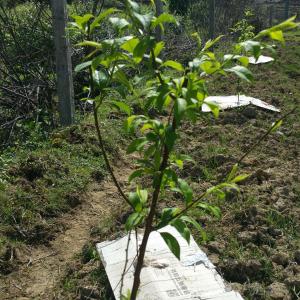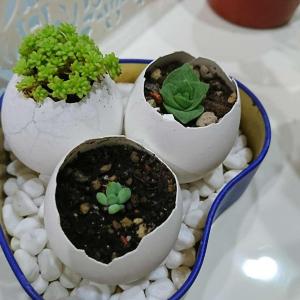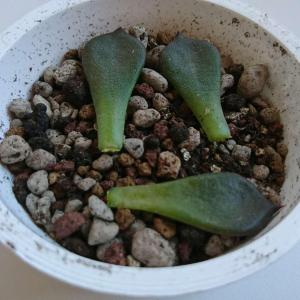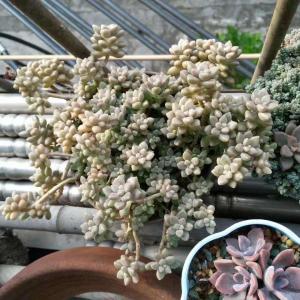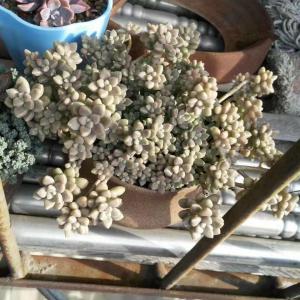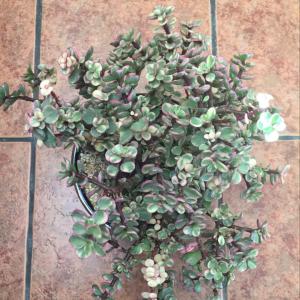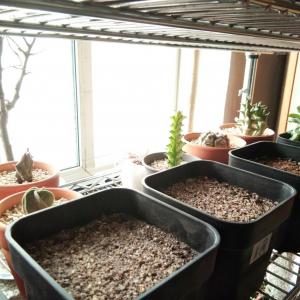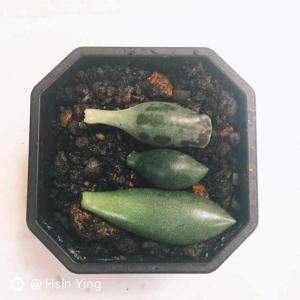文章
Miss Chen
2018年04月09日

Eggplant (Solanum melongena) is winter hardy and perennial in U.S. Department of Agriculture plant hardiness zones 9 to 12, but in most parts of the country it is grown as an annual garden vegetable. It is not tolerant of cold temperatures, and for good fruit development, it requires a long frost-free growing season. The plant is thought to have originated in India more than 1,500 years ago and to have come to North America with Spanish explorers sometime before the 19th century.
Seedlings
Eggplant seeds take one to two weeks to germinate after they're planted, and seedlings will be big and sturdy enough to transplant outdoors within six to 10 weeks after germination. Young plants are vulnerable to damage from frost and cold temperatures, so seedlings shouldn't be transplanted until the soil is warm, nighttime temperatures are consistently above 65 degrees Fahrenheit, and all danger of frost has passed.

Mature Plants
Mature plants are relatively large with branching stems, and their large leaves are oval-shaped or lobed, with a hairy, sometimes spiny, texture. Most eggplant varieties grow to a height of between 2 and 4 feet and may need support from a stake or cage when they're laden with heavy fruit. Some varieties, however, are compact and remain less than 2 feet tall.
In mid-summer, plants bloom with star-shaped purple flowers which occur either singly or in clusters of two blossoms.
The optimal daytime temperature for the plant's growth is between 70 and 85 degrees F, and if temperatures are above 95 degrees F, flowers and fruit may not develop properly.
Fruit Development
The flowers develop into fruit that, depending on the cultivar, vary in size, color and shape. The varieties traditionally grown in the United States produce fruit that is oval or pear-shaped and up to approximately 9 inches long, with a thick purple-black skin and dense white inner flesh. Varieties known as Asian, Chinese or Japanese eggplant produce fruit that is more elongated and slender. The fruit of other cultivars may be white, green, light purple or striped.

Eggplant fruit is ready for harvest when its skin is smooth and shiny and its flesh is firm. Fruit with dull or wrinkled skin or soft flesh is over-ripe; at this stage, the fruit's skin will be tough and its flavor likely bitter. Mature fruit is typically ready to harvest about 70 days after the plants have been set in the garden.
Seedlings
Eggplant seeds take one to two weeks to germinate after they're planted, and seedlings will be big and sturdy enough to transplant outdoors within six to 10 weeks after germination. Young plants are vulnerable to damage from frost and cold temperatures, so seedlings shouldn't be transplanted until the soil is warm, nighttime temperatures are consistently above 65 degrees Fahrenheit, and all danger of frost has passed.

Mature Plants
Mature plants are relatively large with branching stems, and their large leaves are oval-shaped or lobed, with a hairy, sometimes spiny, texture. Most eggplant varieties grow to a height of between 2 and 4 feet and may need support from a stake or cage when they're laden with heavy fruit. Some varieties, however, are compact and remain less than 2 feet tall.
In mid-summer, plants bloom with star-shaped purple flowers which occur either singly or in clusters of two blossoms.
The optimal daytime temperature for the plant's growth is between 70 and 85 degrees F, and if temperatures are above 95 degrees F, flowers and fruit may not develop properly.
Fruit Development
The flowers develop into fruit that, depending on the cultivar, vary in size, color and shape. The varieties traditionally grown in the United States produce fruit that is oval or pear-shaped and up to approximately 9 inches long, with a thick purple-black skin and dense white inner flesh. Varieties known as Asian, Chinese or Japanese eggplant produce fruit that is more elongated and slender. The fruit of other cultivars may be white, green, light purple or striped.

Eggplant fruit is ready for harvest when its skin is smooth and shiny and its flesh is firm. Fruit with dull or wrinkled skin or soft flesh is over-ripe; at this stage, the fruit's skin will be tough and its flavor likely bitter. Mature fruit is typically ready to harvest about 70 days after the plants have been set in the garden.
0
0
文章
Miss Chen
2018年04月06日

Description: This plant is a trailing or climbing annual vine about 3-9' long that branches occasionally. The slender stems are light green, gray-green, or dull red, terete, and hairy; they can climb by twining around the stems or branches of neighboring plants. Alternate trifoliate leaves occur at intervals along the stems. The leaflets are 1-2" long and ½–1¼" across; the terminal leaflet is usually a little larger than the lateral leaflets. The leaflets are broadly lanceolate to ovate with well-rounded bases and smooth margins; the terminal leaflet has a short stalk at its base (petiolule), while the lateral leaflets are nearly sessile. For this variety of Strophostyles helvula, the leaflets lack obtuse basal lobes, unlike the typical variety. The upper leaflet surfaces are medium green and hairless (or nearly so), while their lowers surfaces are pale green and hairless (or nearly so). The slender petioles of the trifoliate leaves are about 1-2" long; they are usually slightly pubescent. At the base of each petiole, there is a pair of tiny linear-lanceolate stipules.
At the axils of some leaves, there develops individual stalks (peduncles) of flowers; these stalks are 3-6" long. At the apex of each stalk, there is a dense cluster of 3-10 nearly sessile flowers; usually only 1-2 flowers are in bloom at the same time. Each flower is about 1/3" long or a little more, its petals consisting of a large rounded banner, a pair of slender lateral petals, and a narrow keel that is curled upward. These petals are light pink to pink, fading to white or pale green; at the bottom of the banner, there is a small patch of yellow. At the base of each flower, there is a short tubular calyx with 5 teeth; this calyx is sparsely hairy. At the base of each calyx, there are lanceolate tiny bracts with pointed tips that are about the same length as the calyx. The blooming period occurs from mid-summer to early fall and lasts about 2 months. Each fertile flower is replaced by a cylindrical seedpod that is 2–3½" long at maturity. The seedpod is initially green, but later becomes dark brown; it is nearly glabrous to sparsely hairy. Individual seeds are about ¼" long, oblongoid in shape, and pubescent. Each seedpod eventually divides into two parts to disperse the seeds.

Cultivation: The preference is partial sun, moist to mesic conditions, and soil containing sand, loam, silt, or gravelly soil. The root system can fix nitrogen in the soil.
Range & Habitat: This native wildflower is occasional throughout Illinois (see Distribution Map); the map does not differentiate between var. missouriensis and the typical variety, Strophostyles helvula helvula (Trailing Fuzzy Bean). Missouri Fuzzy Bean is less common than the typical variety and it is found primarily in counties along the Mississippi River. Habitats of both varieties include open woodlands (including sandy and rocky woodlands), thickets and sandy thickets, riverbanks, sand bars and gravel bars along rivers, abandoned fields, and areas along railroads. Habitats with some history of disturbance are preferred.

Faunal Associations: The flowers are cross-pollinated by bees, especially Large Leaf-Cutting bees (Megachile spp.) and bumblebees. One bee species, Megachile integra, is a specialist pollinator (oligolege) of Strophostyles spp. (Fuzzy Beans). Both nectar and pollen are available as floral rewards. Missouri Fuzzy Bean also has extra-floral nectaries, which attract primarily wasps, flies, ants, and small Halictid bees. The extra-floral nectaries may prevent nectar thieves (e.g., ants) from stealing nectar from the flowers, or they may attract insects (e.g., ants & wasps) that help to protect the plant from insects that feed on the foliage. Insect feeders of the foliage include the caterpillars of Thorybes bathyllus (Southern Cloudywing), Epargyreus clarus (Silver-Spotted Skipper), and Urbanus proteus (Long-Tailed Skipper). The leaf beetles Cerotoma trifurcata and Sumitrosis ancoroides also feed on the foliage. The seeds are eaten by such birds as the Wild Turkey, Bobwhite, and Mourning Dove, while the foliage is readily consumed by cattle, deer, and probably other mammalian herbivores.
Photographic Location: The wildflower garden of the webmaster in Urbana, Illinois.

Comments: Missouri Fuzzy Bean is one of several species in the Fabaceae (Bean family) that are vines. It has fairly typical pea-like flowers for species in this family, except that the keels of the flowers curl upward in an odd manner. Another distinctive characteristic of Strophostyles spp. (Fuzzy Beans) is the production of dense clusters of flowers on long stalks (although only a few flowers bloom at the same time per cluster). The common name 'Fuzzy Bean' refers to the hairiness of the seedpods and/or the pubescent seeds of many species in this genus. As already mentioned, Missouri Fuzzy Bean differs from the typical variety, Strophostyles helvula helvula (Trailing Fuzzy Bean), by the lack of obtuse basal lobes on its leaflets. Because of this characteristic, Missouri Fuzzy Bean can be difficult to distinguish from Strophostyles umbellata (Perennial Fuzzy Bean), which has similar leaflets. For Missouri Fuzzy Bean, the tiny bracts at the base of each flower are about as long as the calyx and they have pointed tips. In contrast, the tiny bracts of Perennial Fuzzy Bean are only one-half as long as the calyx and they have blunt tips. Another species, Strophostyles leiosperma (Small Fuzzy Bean), has smaller leaves and flowers, while the calyx of each flower is densely hairy. Sometimes the scientific name Strophostyles helvula is spelled 'Strophostyles helvola,' which is apparently incorrect.
At the axils of some leaves, there develops individual stalks (peduncles) of flowers; these stalks are 3-6" long. At the apex of each stalk, there is a dense cluster of 3-10 nearly sessile flowers; usually only 1-2 flowers are in bloom at the same time. Each flower is about 1/3" long or a little more, its petals consisting of a large rounded banner, a pair of slender lateral petals, and a narrow keel that is curled upward. These petals are light pink to pink, fading to white or pale green; at the bottom of the banner, there is a small patch of yellow. At the base of each flower, there is a short tubular calyx with 5 teeth; this calyx is sparsely hairy. At the base of each calyx, there are lanceolate tiny bracts with pointed tips that are about the same length as the calyx. The blooming period occurs from mid-summer to early fall and lasts about 2 months. Each fertile flower is replaced by a cylindrical seedpod that is 2–3½" long at maturity. The seedpod is initially green, but later becomes dark brown; it is nearly glabrous to sparsely hairy. Individual seeds are about ¼" long, oblongoid in shape, and pubescent. Each seedpod eventually divides into two parts to disperse the seeds.

Cultivation: The preference is partial sun, moist to mesic conditions, and soil containing sand, loam, silt, or gravelly soil. The root system can fix nitrogen in the soil.
Range & Habitat: This native wildflower is occasional throughout Illinois (see Distribution Map); the map does not differentiate between var. missouriensis and the typical variety, Strophostyles helvula helvula (Trailing Fuzzy Bean). Missouri Fuzzy Bean is less common than the typical variety and it is found primarily in counties along the Mississippi River. Habitats of both varieties include open woodlands (including sandy and rocky woodlands), thickets and sandy thickets, riverbanks, sand bars and gravel bars along rivers, abandoned fields, and areas along railroads. Habitats with some history of disturbance are preferred.

Faunal Associations: The flowers are cross-pollinated by bees, especially Large Leaf-Cutting bees (Megachile spp.) and bumblebees. One bee species, Megachile integra, is a specialist pollinator (oligolege) of Strophostyles spp. (Fuzzy Beans). Both nectar and pollen are available as floral rewards. Missouri Fuzzy Bean also has extra-floral nectaries, which attract primarily wasps, flies, ants, and small Halictid bees. The extra-floral nectaries may prevent nectar thieves (e.g., ants) from stealing nectar from the flowers, or they may attract insects (e.g., ants & wasps) that help to protect the plant from insects that feed on the foliage. Insect feeders of the foliage include the caterpillars of Thorybes bathyllus (Southern Cloudywing), Epargyreus clarus (Silver-Spotted Skipper), and Urbanus proteus (Long-Tailed Skipper). The leaf beetles Cerotoma trifurcata and Sumitrosis ancoroides also feed on the foliage. The seeds are eaten by such birds as the Wild Turkey, Bobwhite, and Mourning Dove, while the foliage is readily consumed by cattle, deer, and probably other mammalian herbivores.
Photographic Location: The wildflower garden of the webmaster in Urbana, Illinois.

Comments: Missouri Fuzzy Bean is one of several species in the Fabaceae (Bean family) that are vines. It has fairly typical pea-like flowers for species in this family, except that the keels of the flowers curl upward in an odd manner. Another distinctive characteristic of Strophostyles spp. (Fuzzy Beans) is the production of dense clusters of flowers on long stalks (although only a few flowers bloom at the same time per cluster). The common name 'Fuzzy Bean' refers to the hairiness of the seedpods and/or the pubescent seeds of many species in this genus. As already mentioned, Missouri Fuzzy Bean differs from the typical variety, Strophostyles helvula helvula (Trailing Fuzzy Bean), by the lack of obtuse basal lobes on its leaflets. Because of this characteristic, Missouri Fuzzy Bean can be difficult to distinguish from Strophostyles umbellata (Perennial Fuzzy Bean), which has similar leaflets. For Missouri Fuzzy Bean, the tiny bracts at the base of each flower are about as long as the calyx and they have pointed tips. In contrast, the tiny bracts of Perennial Fuzzy Bean are only one-half as long as the calyx and they have blunt tips. Another species, Strophostyles leiosperma (Small Fuzzy Bean), has smaller leaves and flowers, while the calyx of each flower is densely hairy. Sometimes the scientific name Strophostyles helvula is spelled 'Strophostyles helvola,' which is apparently incorrect.
0
0
文章
Miss Chen
2018年03月31日

Description: This herbaceous perennial plant is 3-9' tall, consisting of a central stem that is more or less erect, and occasional lateral stems in the upper half of the plant that are ascending. These stems are light green, terete, glabrous to sparsely pubescent, and often glaucous. The alternate leaves can be quite large, up to 18" long and 18" across, becoming smaller as they ascend the stems. They have 3-5 palmate lobes; both the sinuses and tips of the lobes are acutely angled. The leaf margins are coarsely dentate. The upper leaf surfaces are medium to dark green and glabrous, while the lower leaf surfaces are pale green and glabrous to sparsely pubescent.

The petioles are usually a little shorter than the leaves (up to 8" long); they are light green and glabrous to sparsely pubescent. At the base of each petiole, there is a pair of linear stipules about ¼" in length. The central and upper stems terminate in one or more panicles of flowers up to 2' long and 2' across. The branches and pedicels of these panicles are light green and glabrous to sparsely pubescent. There are small leafy bracts (less than 3" long) that are located where the branches of the panicle diverge. The flowers tend to be organized into clusters near the tips of the terminal branches; their pedicels are up to 1" long. Because Glade Mallow is dioecious, each flowering plant has either all male (staminate) or all female (pistillate) flowers, but not both. Each male flower is about ½-¾" across, consisting of a short-tubular calyx with 5 broad teeth, 5 white petals, and several stamens; the latter are joined together into a narrow white column. At the apex of this column, the stamens become separated into short white filaments and small plumes of tan to pink anthers. The calyx is light green and glabrous, while the petals are widely spreading and obovate to oblanceolate in shape.

Each female flower is about ½-¾" across, consisting of a short-tubular calyx with 5 broad teeth, 5 white petals, and a compound pistil with several white styles. The calyx is light green and glabrous, while the petals are widely spreading and obovate in shape. The blooming period occurs from early to mid-summer, lasting about 1 month. There is a pleasant floral fragrance. Afterwards, the female flowers are replaced by dry fruits (schizocarps); there are 8-10 seeds per fruit that are probably distributed to some extent by water. The root system consists of a hollow taproot that branches occasionally, and it also produces rhizomes. Colonies of plants can develop from the rhizomes.

Cultivation: The preference is partial to full sun, moist conditions, and soil consisting of loam or silt-loam with decaying organic matter. This plant doesn't like to dry out, and the leaves will wilt rapidly and become ragged in appearance if this is allowed to happen. It may also topple over in a strong wind, particularly when the flowering stage is reached. Therefore, plant the Glade Mallow in a moist, sheltered location. Disease does not appear to be a significant problem. Propagation can be accomplished by seed through cold moist stratification or by division of the rhizomes.

Habitat & Range: The Glade Mallow is an uncommon plant that occurs sporadically in the northern half of Illinois (see Distribution Map), where it is native. This plant is endemic to the Midwest. Habitats include river-bottom prairies, soggy thickets, openings in floodplain forests, terraces along rivers, low areas along streams, and depressions along railroads. This plant doesn't occur in glades in the hillier parts of southern Illinois, contrary to what its common name suggests. Occasional wildfires, particularly during the spring or autumn, are probably beneficial as this reduces the encroachment of woody vegetation.

Faunal Associations: The flowers are cross-pollinated by bumblebees (Bombus spp.), Halictid bees (Lasioglossum spp.), and Andrenid bees (Andrena spp.); they are also visited by Syrphid flies and Calliphorid flies. These insects are attracted to the nectar and pollen of the flowers (Iltis, 1963). The foliage of Glade Mallow is readily browsed by cattle and other farm animals, and it may also be consumed by deer. Because this is a large leafy plant that often forms colonies, it provides significant cover for a variety of vertebrate animals and insects.
Photographic Location: Dave Monk's postage stamp prairie in downtown Champaign, Illinois, and a wildflower garden in Urbana, Illinois. The population of plants at the former location no longer exists.
Comments: Overall, this wildflower is very showy while it is in bloom. It is the only member of the genus that occurs in Illinois. Because of its unisexual flowers, the Glade Mallow is one of the more unusual members of the Mallow family. Its range is restricted to only a few states in the Midwest. Its flowers are much smaller in size than those of the native Rose Mallows (Hibiscus spp.) and rare Kankakee Mallow (Iliamna remota), but they are more numerous. The most similar species to the Glade Mallow is the River Mallow (Sida hermaphrodita). Like the Glade Mallow, the River Mallow is a tall-growing mallow with small white flowers that are produced in abundance; both of these species prefer similar damp habitats. This latter species, however, has bisexual flowers and the lobes of its palmate leaves are more narrow and pointed than those of the Glade Mallow. The River Mallow is not found in Illinois; it has a more eastern distribution.

The petioles are usually a little shorter than the leaves (up to 8" long); they are light green and glabrous to sparsely pubescent. At the base of each petiole, there is a pair of linear stipules about ¼" in length. The central and upper stems terminate in one or more panicles of flowers up to 2' long and 2' across. The branches and pedicels of these panicles are light green and glabrous to sparsely pubescent. There are small leafy bracts (less than 3" long) that are located where the branches of the panicle diverge. The flowers tend to be organized into clusters near the tips of the terminal branches; their pedicels are up to 1" long. Because Glade Mallow is dioecious, each flowering plant has either all male (staminate) or all female (pistillate) flowers, but not both. Each male flower is about ½-¾" across, consisting of a short-tubular calyx with 5 broad teeth, 5 white petals, and several stamens; the latter are joined together into a narrow white column. At the apex of this column, the stamens become separated into short white filaments and small plumes of tan to pink anthers. The calyx is light green and glabrous, while the petals are widely spreading and obovate to oblanceolate in shape.

Each female flower is about ½-¾" across, consisting of a short-tubular calyx with 5 broad teeth, 5 white petals, and a compound pistil with several white styles. The calyx is light green and glabrous, while the petals are widely spreading and obovate in shape. The blooming period occurs from early to mid-summer, lasting about 1 month. There is a pleasant floral fragrance. Afterwards, the female flowers are replaced by dry fruits (schizocarps); there are 8-10 seeds per fruit that are probably distributed to some extent by water. The root system consists of a hollow taproot that branches occasionally, and it also produces rhizomes. Colonies of plants can develop from the rhizomes.

Cultivation: The preference is partial to full sun, moist conditions, and soil consisting of loam or silt-loam with decaying organic matter. This plant doesn't like to dry out, and the leaves will wilt rapidly and become ragged in appearance if this is allowed to happen. It may also topple over in a strong wind, particularly when the flowering stage is reached. Therefore, plant the Glade Mallow in a moist, sheltered location. Disease does not appear to be a significant problem. Propagation can be accomplished by seed through cold moist stratification or by division of the rhizomes.

Habitat & Range: The Glade Mallow is an uncommon plant that occurs sporadically in the northern half of Illinois (see Distribution Map), where it is native. This plant is endemic to the Midwest. Habitats include river-bottom prairies, soggy thickets, openings in floodplain forests, terraces along rivers, low areas along streams, and depressions along railroads. This plant doesn't occur in glades in the hillier parts of southern Illinois, contrary to what its common name suggests. Occasional wildfires, particularly during the spring or autumn, are probably beneficial as this reduces the encroachment of woody vegetation.

Faunal Associations: The flowers are cross-pollinated by bumblebees (Bombus spp.), Halictid bees (Lasioglossum spp.), and Andrenid bees (Andrena spp.); they are also visited by Syrphid flies and Calliphorid flies. These insects are attracted to the nectar and pollen of the flowers (Iltis, 1963). The foliage of Glade Mallow is readily browsed by cattle and other farm animals, and it may also be consumed by deer. Because this is a large leafy plant that often forms colonies, it provides significant cover for a variety of vertebrate animals and insects.
Photographic Location: Dave Monk's postage stamp prairie in downtown Champaign, Illinois, and a wildflower garden in Urbana, Illinois. The population of plants at the former location no longer exists.
Comments: Overall, this wildflower is very showy while it is in bloom. It is the only member of the genus that occurs in Illinois. Because of its unisexual flowers, the Glade Mallow is one of the more unusual members of the Mallow family. Its range is restricted to only a few states in the Midwest. Its flowers are much smaller in size than those of the native Rose Mallows (Hibiscus spp.) and rare Kankakee Mallow (Iliamna remota), but they are more numerous. The most similar species to the Glade Mallow is the River Mallow (Sida hermaphrodita). Like the Glade Mallow, the River Mallow is a tall-growing mallow with small white flowers that are produced in abundance; both of these species prefer similar damp habitats. This latter species, however, has bisexual flowers and the lobes of its palmate leaves are more narrow and pointed than those of the Glade Mallow. The River Mallow is not found in Illinois; it has a more eastern distribution.
0
0
文章
Miss Chen
2018年03月30日

Description: This perennial plant is up to 6' tall and unbranched, except at the inflorescence. The central stem is stout and smooth. The leaves usually occur in whorls of 3-9 along the stem, although some of the upper leaves may occur along the stem in pairs or alternate individually. The leaves are individually up to 7" long and 1" across, rather stiff in texture, and sometimes curve upward along their margins. They are lanceolate or narrowly ovate, with smooth margins and parallel venation. Above the terminal leaves of the central stem, 1-12 flowers hang downward from stalks about 4-8" long that spread upward and outward. Some flowering stalks may also appear from the axils of the upper leaves. Each showy flower is about 3-4" across, with 6 tepals that flare outward and then curve strongly backward beyond the base of the flower. These tepals are yellowish orange or green near the base of the flower, and become orange to dark orange towards their tips. They have numerous brownish purple dots toward the throat of the flower. The stamens are quite conspicuous and strongly exerted from the base of the flower, with reddish brown to black anthers that are ½" long or longer in length. They surround a long whitish orange stigma that curls slightly upward and is orange or brown toward its tip. The blooming period occurs from early to mid-summer, and lasts about a month. There is no noticeable floral scent. The oblong 3-lobed seedpods contain closely stacked, flat seeds with thin papery wings – this enables them to be carried some distance by gusts of wind. The root system consists of a white bulb, from which new offsets may form.
Cultivation: The preference is full or partial sun, rich loamy soil, and moist conditions. An established plant, however, can withstand some drought. Growing this plant from seeds is slow and difficult, but relatively easy from bulbs or transplants. There is some tendency to flop over if there is inadequate support from neighboring plants.
Range & Habitat: The native Turk's Cap Lily occurs primarily in a few counties in southern Illinois (see Distribution Map). This is a rare plant in the wild in Illinois, although it is occasionally cultivated in gardens because of the showy flowers. Habitats include moist meadows in woodland areas, open woodlands and young flatwoods, thickets, and areas along lakes. This plant is occasionally introduced into natural areas outside of its original range.

Faunal Associations: Cross-pollination is required for fertile seeds. The large showy flowers appear to be designed to attract hummingbirds and larger day-flying insects, such as Sphinx moths, Hummingbird moths, long-tongued bees, and the larger butterflies. Charles Robertson in Flowers and Insects (1929) observed the Greater Fritillary, Monarch, and Spicebush Swallowtail butterflies as occasional visitors to Lilium superbum, which was probably Lilium michiganense, as the former species doesn't occur near Carlinville, Illinois. Larger herbivores, such as deer and livestock, will consume mature plants, while immature plants are vulnerable to small herbivores. Small rodents may eat the bulbs.
Photographic Location: The photographs were taken at Meadowbrook Park in Urbana, Illinois, where this species was introduced.

Comments: This is a very beautiful plant. The Turk's Cap Lily can be distinguished from the more common Lilium michiganense (Michigan Lily) as follows: 1) the former species is restricted to southern Illinois, although it may be introduced elsewhere; 2) some of the anthers of the former are greater than ½" long, while the anthers of the latter species are always less than ½" long; 3) the former has white bulbs, while the latter has yellow bulbs, and 4) the former species may have a conspicuous 6-pointed green star at the base of the flower, although this feature isn't always present in some local ecotypes. The stamens of Turk's Cap Lily are even more strongly exerted from the throat of the flower than is the case for the Michigan Lily, and it tends to be a taller, more robust plant.
Cultivation: The preference is full or partial sun, rich loamy soil, and moist conditions. An established plant, however, can withstand some drought. Growing this plant from seeds is slow and difficult, but relatively easy from bulbs or transplants. There is some tendency to flop over if there is inadequate support from neighboring plants.
Range & Habitat: The native Turk's Cap Lily occurs primarily in a few counties in southern Illinois (see Distribution Map). This is a rare plant in the wild in Illinois, although it is occasionally cultivated in gardens because of the showy flowers. Habitats include moist meadows in woodland areas, open woodlands and young flatwoods, thickets, and areas along lakes. This plant is occasionally introduced into natural areas outside of its original range.

Faunal Associations: Cross-pollination is required for fertile seeds. The large showy flowers appear to be designed to attract hummingbirds and larger day-flying insects, such as Sphinx moths, Hummingbird moths, long-tongued bees, and the larger butterflies. Charles Robertson in Flowers and Insects (1929) observed the Greater Fritillary, Monarch, and Spicebush Swallowtail butterflies as occasional visitors to Lilium superbum, which was probably Lilium michiganense, as the former species doesn't occur near Carlinville, Illinois. Larger herbivores, such as deer and livestock, will consume mature plants, while immature plants are vulnerable to small herbivores. Small rodents may eat the bulbs.
Photographic Location: The photographs were taken at Meadowbrook Park in Urbana, Illinois, where this species was introduced.

Comments: This is a very beautiful plant. The Turk's Cap Lily can be distinguished from the more common Lilium michiganense (Michigan Lily) as follows: 1) the former species is restricted to southern Illinois, although it may be introduced elsewhere; 2) some of the anthers of the former are greater than ½" long, while the anthers of the latter species are always less than ½" long; 3) the former has white bulbs, while the latter has yellow bulbs, and 4) the former species may have a conspicuous 6-pointed green star at the base of the flower, although this feature isn't always present in some local ecotypes. The stamens of Turk's Cap Lily are even more strongly exerted from the throat of the flower than is the case for the Michigan Lily, and it tends to be a taller, more robust plant.
0
0
文章
Miss Chen
2018年03月16日

Grow your own salad at home with a backyard patch of lettuce (Lactuca sativa), which thrives throughout U.S. Department of Agriculture plant hardiness zones 4 through 9. Since this vegetable is prized for its crisp, edible leaves, yellowing foliage can ruin your dreams of a homemade salad harvest. Lettuce may turn yellow for a few common reasons, each which has an organic, natural solution.
Not Enough Water
The lettuce plant has a very shallow root system, which makes it especially prone to drought stress. The plant requires consistently moist soil conditions at all times, without which it will wilt, turn yellow and eventually lose all of its leaves.
When watering lettuce, use enough irrigation to moisten the soil to a depth of 6 inches. Water the lettuce bed again as soon as the top inch of soil has dried out.
Extreme Soil Temperature Fluctuations
Since lettuce roots lie so close to the soil surface, the plant is more prone to temperature-induced stress that can result in wilting and yellowing of the lettuce leaves. Mulch creates a protective barrier on the soil surface that helps to shield the soil from the sun and keeps temperatures constant and cool.

Spread 2 to 3 inches of organic mulch around the lettuce plants. Example mulching materials include:
Shredded leaves
Weed-free straw or hay
Fine bark chips
Compost
Additionally, mulch helps prevent weed growth and also conserves soil moisture, further enhancing the lettuce plant's health and appearance.
Poor Soil Nutrient Levels
As lettuce grows, it needs rich levels of soil nutrients to support optimal foliage development. Nutrient-depleted soil may result in lettuce plants that appear stunted with leaves that aren't fully developed or that have a pale, yellow-green hue. When given the right amount of fertilizer, lettuce leaves turn a dark green.
Before planting lettuce, set a nutritional foundation by spreading 1 1/2 pounds of 5-10-10 fertilizer for every 50 square feet of gardening space. A couple months after the lettuce has been planted, fertilize the garden again with 1/2 pound of 33-0-0 fertilizer for every 50 feet of lettuce row.
Pest Invasions
You are not the only thing that enjoys the taste of lettuce. Occasionally, lettuce beds may get attacked by a variety of soft-bodied pests, including aphids, leafhoppers and whiteflies. Left uncontrolled, pest infestations can reach such heavy numbers that they cause wilting, yellowing or loss of leaves. Some pests, such as the leafhopper, spread a disease called yellows disease that, true to its name, causes yellow leaves.
Dust lettuce plants with food-grade diatomaceous earth to protect it from leafhoppers and other leaf-eating pests. Repeat the diatomaceous earth application after any rainy days.

Alternatively, spray lettuce plants with a strong blast of water from a garden hose. This is often enough to dislodge and kill common pests like aphids and whiteflies, and regular spraying keeps pest populations at levels too low to cause a problem.
If all else fails, make your own homemade insecticide soap spray to kill aphids, leafhoppers and other soft-bodied pests.
Step 1
Place an entire garlic bulb and a small onion into a blender and blend on medium until a fine pulp is created.
Step 2
Add 1 teaspoon of powdered, dehydrated cayenne pepper.
Step 3
Add 1 quart of water.
Step 4
Mix thoroughly and allow to steep of an hour, but preferably overnight.
Step 5
Pour the liquid through a piece of cheesecloth into a plastic spray bottle.
Step 6
Add 1 tablespoon of liquid dish soap.
Step 7
Spray the soapy solution on affected lettuce plants. Coat all exposed surfaces of the plant, including the undersides of leaves where aphids and other pests tend to congregate.
Step 8
Repeat once a week until pest activity subsides.
Not Enough Water
The lettuce plant has a very shallow root system, which makes it especially prone to drought stress. The plant requires consistently moist soil conditions at all times, without which it will wilt, turn yellow and eventually lose all of its leaves.
When watering lettuce, use enough irrigation to moisten the soil to a depth of 6 inches. Water the lettuce bed again as soon as the top inch of soil has dried out.
Extreme Soil Temperature Fluctuations
Since lettuce roots lie so close to the soil surface, the plant is more prone to temperature-induced stress that can result in wilting and yellowing of the lettuce leaves. Mulch creates a protective barrier on the soil surface that helps to shield the soil from the sun and keeps temperatures constant and cool.

Spread 2 to 3 inches of organic mulch around the lettuce plants. Example mulching materials include:
Shredded leaves
Weed-free straw or hay
Fine bark chips
Compost
Additionally, mulch helps prevent weed growth and also conserves soil moisture, further enhancing the lettuce plant's health and appearance.
Poor Soil Nutrient Levels
As lettuce grows, it needs rich levels of soil nutrients to support optimal foliage development. Nutrient-depleted soil may result in lettuce plants that appear stunted with leaves that aren't fully developed or that have a pale, yellow-green hue. When given the right amount of fertilizer, lettuce leaves turn a dark green.
Before planting lettuce, set a nutritional foundation by spreading 1 1/2 pounds of 5-10-10 fertilizer for every 50 square feet of gardening space. A couple months after the lettuce has been planted, fertilize the garden again with 1/2 pound of 33-0-0 fertilizer for every 50 feet of lettuce row.
Pest Invasions
You are not the only thing that enjoys the taste of lettuce. Occasionally, lettuce beds may get attacked by a variety of soft-bodied pests, including aphids, leafhoppers and whiteflies. Left uncontrolled, pest infestations can reach such heavy numbers that they cause wilting, yellowing or loss of leaves. Some pests, such as the leafhopper, spread a disease called yellows disease that, true to its name, causes yellow leaves.
Dust lettuce plants with food-grade diatomaceous earth to protect it from leafhoppers and other leaf-eating pests. Repeat the diatomaceous earth application after any rainy days.

Alternatively, spray lettuce plants with a strong blast of water from a garden hose. This is often enough to dislodge and kill common pests like aphids and whiteflies, and regular spraying keeps pest populations at levels too low to cause a problem.
If all else fails, make your own homemade insecticide soap spray to kill aphids, leafhoppers and other soft-bodied pests.
Step 1
Place an entire garlic bulb and a small onion into a blender and blend on medium until a fine pulp is created.
Step 2
Add 1 teaspoon of powdered, dehydrated cayenne pepper.
Step 3
Add 1 quart of water.
Step 4
Mix thoroughly and allow to steep of an hour, but preferably overnight.
Step 5
Pour the liquid through a piece of cheesecloth into a plastic spray bottle.
Step 6
Add 1 tablespoon of liquid dish soap.
Step 7
Spray the soapy solution on affected lettuce plants. Coat all exposed surfaces of the plant, including the undersides of leaves where aphids and other pests tend to congregate.
Step 8
Repeat once a week until pest activity subsides.
0
0



